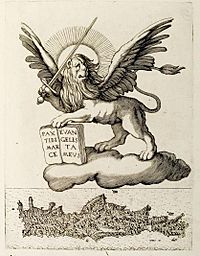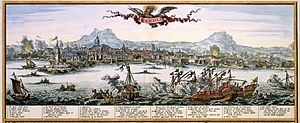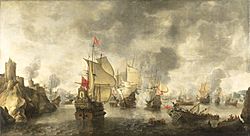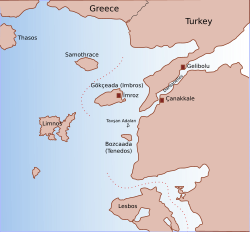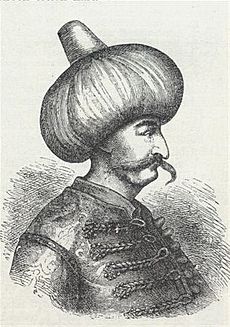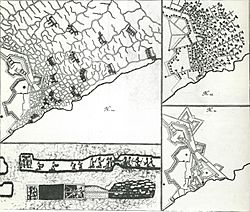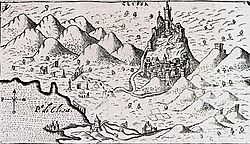Cretan War (1645–1669) facts for kids
Quick facts for kids Cretan War(Fifth Ottoman–Venetian War) |
|||||||||
|---|---|---|---|---|---|---|---|---|---|
| Part of the Ottoman–Venetian Wars | |||||||||
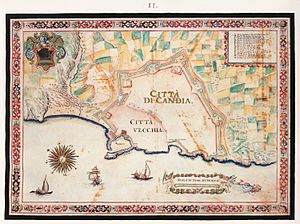 A Venetian map of Candia |
|||||||||
|
|||||||||
| Belligerents | |||||||||
| Commanders and leaders | |||||||||
| Casualties and losses | |||||||||
| 30,985 Venetian soldiers (Venetian claim) | 118,754 Ottoman soldiers (Venetian claim) | ||||||||
The Cretan War, also known as the War of Candia, was a long fight between the Republic of Venice and its friends against the Ottoman Empire. It was called the Cretan War because most of the fighting happened on the island of Crete. Crete was Venice's biggest and richest overseas land.
The war lasted from 1645 to 1669, which is 24 years! Battles took place in Crete, especially around the city of Candia. There were also many sea battles and raids in the Aegean Sea. Another smaller area of fighting was in Dalmatia.
Even though the Ottomans took most of Crete early in the war, the strong fortress of Candia held out. Its long siege became famous. Both sides had to focus on getting supplies and fresh soldiers to the island. Venice hoped to win by stopping Ottoman supplies. This turned the war into many naval battles.
Venice got help from other European countries. The Pope and a renewed crusading spirit encouraged them to send ships, men, and supplies. Venice usually had better ships and won most sea battles. But they could not fully stop the Ottomans from sending supplies to Crete. The Ottomans also faced problems at home.
The long war made Venice's economy very weak. By the 1660s, people were tired of fighting, even with more help from other Christian nations. The Ottomans, however, got stronger under the Köprülü family. In 1666, they sent a huge army to Crete. This started the final, very bloody part of the Siege of Candia.
The siege ended in 1669 when Candia surrendered. This meant the Ottomans had won the war. In the peace deal, Venice kept a few small island forts near Crete. They also gained some land in Dalmatia. Crete stayed under Ottoman control until 1897.
Contents
Why the War Started
After losing Cyprus in an earlier war, Crete was Venice's last big island. Crete was important because of its location. It was also a tempting target for the Ottomans because it was large and fertile. Its forts were not in good shape.
Venice did not want to make the Ottomans angry. Venice was not very strong militarily. Its economy depended on trade. So, Venice tried to keep peace with the Ottomans for over 60 years. But by the early 1600s, Venice's power had gone down. New trade routes in the Atlantic hurt its economy. Also, a terrible sickness hit Venice in 1629–1631.
There had been small fights before. In 1638, Venetian ships attacked some pirates who were hiding in an Ottoman port. This made Sultan Murad IV very angry. He threatened to punish all Venetians. But since the Ottomans were fighting another war, Venice paid them a large sum of money to make peace.
However, a similar event in 1644 led to war. On September 28, the Knights of Malta attacked an Ottoman convoy. This convoy was carrying important people, including religious travelers going to Mecca. Many people died, and others were taken captive. The Knights stopped at a small port in southern Crete.
The Ottomans were furious. They accused Venice of helping the Knights. Venice strongly denied this. But people in the Ottoman government who wanted war used this as an excuse. Even after long talks, war was decided. A large Ottoman army of over 50,000 soldiers and 416 ships was quickly put together. It sailed from the Dardanelles on April 30, 1645. The Ottomans pretended they were going to Malta to trick Venice.
Fighting on Crete
The Ottomans tricked Venice. Their fleet arrived at Crete on June 23, 1645. Venice was caught by surprise. The island's defenses were not ready.
The Ottomans landed near Canea (Chania). The local soldiers ran away. Then they attacked a small island fort called St. Todero. Its commander, Blasio Zulian, blew up himself and the fort rather than let the Ottomans capture it. The Ottoman army then moved to Canea. The city fell on August 22, after a 56-day siege.
Meanwhile, Venice got help from the Pope, Tuscany, Malta, and Naples. In September, the Ottoman fleet was in trouble. But the Christian fleet did not attack them strongly. When the Christian forces tried to take back Canea on October 1, their attack failed. The Ottomans defended well, and the Christian allies did not work together. Soon after, the allies left.
In November, the Ottoman commander, Silahdar Yusuf Pasha, left soldiers behind and went back to Constantinople for the winter. He was later executed by the Sultan. But the Ottomans kept getting ready for more war. Venice tried to get money and men. They also tried to get other European countries to join them. But most of Europe was busy with the Thirty Years' War.
Venice had money problems because of the war. They taxed their lands in Italy. They even sold noble titles to get money. In 1646, the new Venetian commander, Giovanni Cappello, did not do well. He could not stop Ottoman soldiers from arriving. His attack on the Ottoman fleet failed. The city of Rettimo (Rethymno) fell on October 20.
During the winter of 1646–1647, a terrible sickness hit both sides. In mid-June 1647, a small Ottoman force defeated a larger group of Venetian soldiers. This helped the Ottomans take the eastern part of the island. By 1648, almost 40% of the people on Crete had died from sickness or war. By early 1648, the Ottomans controlled almost all of Crete. Only Candia and a few other strongholds like Gramvousa were still held by Venice.
The Siege of Candia
The siege of Candia started in May 1648. The Ottomans spent three months surrounding the city. They cut off its water supply. This siege lasted until 1669, making it one of the longest sieges in history.
The Ottomans had trouble getting supplies. Christian ships in the Aegean Sea stopped their convoys. Also, the Ottoman government had problems because Sultan Ibrahim was not a good leader. This led to him being removed from power. His son Mehmed IV became Sultan, causing more confusion.
Because of supply problems, the Ottoman commander had to stop the siege in early 1649. But it started again for two months when new Ottoman ships arrived in June. The Ottomans attacked the city walls, using many explosives. But the defenders held strong. The Ottomans lost many men.
The Venetians kept blocking the Dardanelles. But the Ottomans still managed to get enough supplies to Crete. They built new forts around Canea. The Venetian navy won some battles, but they could not stop the siege of Candia. In 1653, the Ottomans took another island fort. The siege of Candia continued until a new Ottoman army arrived in 1666.
Battles at Sea
Venice could not fight the large Ottoman army on Crete directly. But they had a strong navy. This navy could cut off Ottoman supply routes. In 1645, Venice and its allies had many galleys and sailing ships. Venice was good at using both types of ships. The Ottoman navy mostly used galleys at first. Both sides hired merchant ships from the Netherlands and England to help.
Venice's first plan was to block the Dardanelles in 1646. They wanted to stop supplies going to Crete. A Venetian fleet tried to capture the island of Tenedos, near the Dardanelles entrance. The Ottoman fleet tried to fight them but was pushed back. However, the Venetians could not stop the Ottoman fleet from leaving the Dardanelles later. The Ottomans were able to land new soldiers and supplies on Crete.
On January 27, 1647, the Venetians lost their commander, Tommaso Morosini. His ship faced the entire Ottoman fleet. Morosini died, but his ship caused a lot of damage to the Ottomans. The Venetian fleet arrived just in time to save the ship. This fight, where one ship caused so much trouble for a whole fleet, hurt Ottoman morale.
In 1648, the Venetians went back to the Dardanelles. Even after losing ships in a storm, they blocked the Straits for a whole year. The Ottomans built a new fleet to fight back. In 1649, a stronger Ottoman fleet broke the blockade. The Venetians won a battle against the Ottoman fleet on May 12, 1649. But they still could not stop the Ottoman ships from reaching Crete. It was hard for Venice to keep a long blockade.
In 1650, a Venetian fleet kept blocking the Dardanelles. But the Ottoman commander used a trick. He waited until winter when the Venetians left. Then he sailed a small number of ships with soldiers and supplies to Crete.
On July 10, 1651, a big sea battle happened near Naxos. The Venetians won against a much larger Ottoman fleet. But the Ottomans still managed to reach Candia.
Big Battles at the Dardanelles
In 1654, the Ottomans built many new warships. Their fleet was much bigger than the Venetian one. A battle happened on May 16, 1654. The Ottomans won, but the Venetians managed to escape. This was seen as a moral victory for Venice. The Ottoman fleet then raided a Venetian island but retreated.
In 1655, the Venetian commander, Francesco Morosini, took a more active approach. He attacked Ottoman supply bases. In June, he sailed to the Dardanelles. The Ottoman fleet, with 143 ships, appeared on June 21. The Venetians won this battle clearly. The Ottoman fleet avoided fighting for the rest of the year.
Even though Venice had been winning at sea, they could not stop the Ottomans from supplying Crete. But in June 1656, a combined Venetian and Maltese fleet won a huge victory. They destroyed or captured many Ottoman ships. This was the Ottomans' worst naval defeat in a long time. After this win, the Venetians captured the islands of Tenedos and Lemnos. These islands were near the Dardanelles. Using them as bases, the Venetian blockade became much stronger. This cut off supplies to Crete. Constantinople itself had food shortages that winter.
In 1657, the Ottomans fought back. A new, strong leader, Köprülü Mehmed Pasha, was in charge. He made the Ottoman war effort stronger. The Ottoman fleet broke the Venetian blockade. A big battle happened over three days in July. The Venetians caused more damage to the Ottomans. But the Ottomans achieved their goal: the blockade was broken. The Ottomans then took back Lemnos and Tenedos. This ended Venice's hope of blocking the Dardanelles easily.
A Pause in Fighting
In 1658, the Ottomans focused on fighting in Europe. For the next few years, the Venetian fleet tried to block the Dardanelles again, but without much success. Morosini also attacked Ottoman strongholds. He tried to capture an island but failed. But in 1659, the Venetians raided several towns in Greece. However, Venice could not hold these places.
The Ottomans built two new forts at the entrance of the Dardanelles. This was to stop Venetian ships from entering the Straits again.
Meanwhile, Venice was getting tired of the war. Trade was suffering. They tried to make peace with the Ottomans. But the Ottomans wanted all of Crete, which Venice would not agree to. However, a war between France and Spain ended. This made Venice hopeful for more help, especially from France.
Help did come. Soldiers from Western Europe joined Venice's army. Christian rulers also sent men, supplies, and ships. In April 1660, a French group of 4,200 men arrived. But Morosini's attacks in 1660 failed. An attack on Canea did not take the city. An attack on the Candia siege lines also failed. After the French commander died, the French soldiers went home. Morosini also left.
In 1661, the new Venetian commander had some small wins. But the next few years were quiet. Even though the Ottomans were busy fighting in Hungary, Venice did not use this chance to attack.
The Final Stage of the War
While Venice was quiet, the Ottomans were not. After signing a peace treaty in 1664, they could focus all their strength on Crete. The Grand Vizier, Köprülü Fazıl Ahmed, made huge preparations in 1665–1666. He sent 9,000 more men to Crete.
The Ottomans offered peace if Venice would keep Candia and pay them money every year. Venice refused. In May 1666, the Ottoman army, led by the Grand Vizier himself, left for Greece. They would sail to Crete in the winter.
In February 1667, Venice got many new soldiers and ships from France and Savoy. But, as before, the leaders from different countries did not agree on how to fight. The Venetian commander, Francesco Morosini, tried to fight the Ottomans at sea. But the Ottomans avoided battle. They used their many ships and bases to keep their forces on Crete supplied. The only success for the allies in 1667 was stopping an Ottoman raid on Kythera.
On March 8, 1668, the Venetians won a tough night battle. Ottoman ships tried to capture a small Venetian group. Morosini had been warned and sent more ships. Venice won, but it was their last sea victory in this war. The Venetians then tried to block Canea, the Ottomans' main supply base. But the Ottoman fleet, carrying fresh soldiers and supplies, still reached Canea in September.
The Fall of Candia
The new Ottoman army arrived in Crete in the winter of 1666–1667. On May 22, the final part of the siege began. The Grand Vizier himself was in charge. This last phase lasted 28 months. During the attacks, many people died: 108,000 Ottomans and 29,088 Christians. This included many Venetian noblemen.
Venice was facing a strong Ottoman attack and had money problems. Even though more help was coming from Europe, Venice hoped to end the war. They wanted to use the new soldiers to get a better peace deal. But Venice refused an Ottoman offer to keep half of Crete. They were hopeful because of more French help and problems in the Ottoman government.
On June 19, the first part of the French army arrived at Candia. The city was in bad shape. Most of Candia was ruined. The French attacked on June 25. The Ottomans were surprised, but the French got disorganized. An Ottoman counter-attack pushed them back. The French lost about 800 men, including their commander.
More French soldiers arrived, which cheered up the defenders. They planned a combined attack. The allied fleet would bombard the Ottoman lines. On July 25, the attack began with a huge amount of cannon fire. But the Ottomans were well protected. An accident caused a French ship to explode, hurting other French and Venetian ships.
This failure made relations between the French and Venetians worse. They did not work well together. The French soldiers were also sick and tired. The French left on August 20. Two Ottoman attacks on August 25 were stopped. But Morosini knew the city could not be held. On September 5, 1669, Candia surrendered to the Ottomans. The remaining soldiers and citizens were safely moved out.
Morosini made a peace deal with the Ottomans. It was quite fair for Venice. Venice kept the islands of Tinos and Kythera. They also kept the island forts of Spinalonga, Gramvousa, and Souda near Crete. And they kept the land they had gained in Dalmatia.
War in Dalmatia
The fighting in Dalmatia was different. For the Ottomans, it was far away and not very important. But for Venice, it was close to their bases. Venice controlled the sea there, so they could easily send help to their forts.
In 1646, the Ottomans attacked Dalmatia. They captured some islands and the strong fort of Novigrad. This allowed them to threaten Venice's main forts in Dalmatia, Zadar and Split. But in 1647, the Venetians fought back. Their commander, Leonardo Foscolo, took back Novigrad and other forts. The Ottomans tried to capture Šibenik but failed.
For the next few years, fighting slowed down. Both sides focused on the Aegean Sea. Venice gained a lot of land in Dalmatia by the end of the war. Their territory there tripled. This helped Venice control the Adriatic Sea.
What Happened Next
The surrender of Candia ended over 450 years of Venetian rule in Crete. It also meant the Ottoman Empire was at its biggest ever. But the war had cost the Ottomans a lot of money and lives. This helped lead to their decline later in the 1600s.
Venice lost its biggest and richest colony. Its important trading position in the Mediterranean became smaller. And Venice's treasury was empty. The gains in Dalmatia were not enough to make up for these losses.
When Morosini returned to Venice in 1670, he was put on trial. People accused him of not following orders and being disloyal. But he was found innocent. Fifteen years later, he led Venetian forces in another war. Venice tried to get back what they had lost. In that war, in 1692, a Venetian fleet tried to take back Candia but failed. The last Venetian forts near Crete fell in 1715. Crete stayed under Ottoman control until 1897, when it became its own state. It finally joined Greece in 1913.
After Candia fell, people worried the Ottomans would attack Malta. So, in 1670, the Knights of St. John started building new defenses for Malta.
See also
 In Spanish: Guerra de Candía para niños
In Spanish: Guerra de Candía para niños



